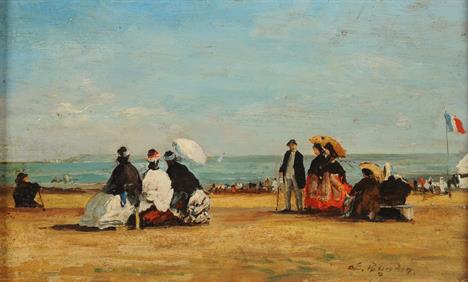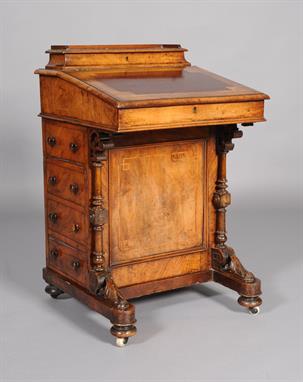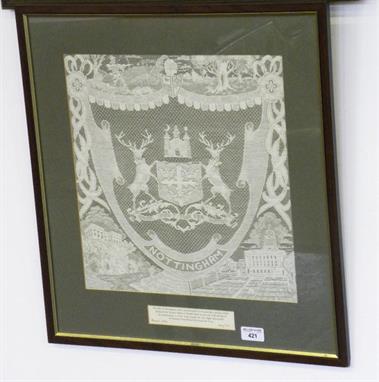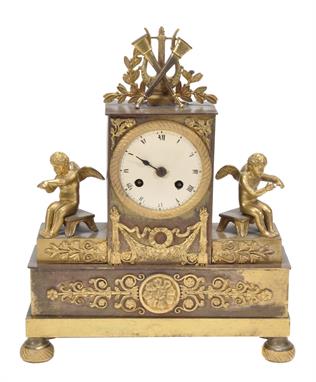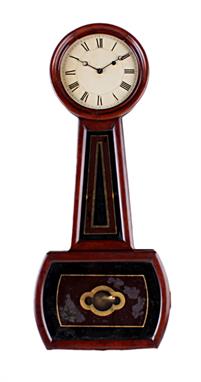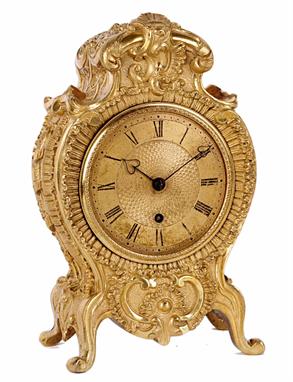We found 360406 price guide item(s) matching your search
There are 360406 lots that match your search criteria. Subscribe now to get instant access to the full price guide service.
Click here to subscribe- List
- Grid
-
360406 item(s)/page
A LOUIS XVI STYLE CARVED AND GILT PLASTER PIER TABLE AND GLASS, the broken semi- circular marble top with moulded border, the frieze blind carved with laurel panels flanking a central paterae and on a chamfered monopodia support carved with a husk swag, hoof terminal, the tall bevelled rectangular mirror within a ribbon-wrapped border, surmounted by a relief-ornamented panel of musical instruments, flowers and foliage, beneath a bead and dart cornice circa 1930s, 48cm wide x 101cm high. See illustration
A VICTORIAN FIGURED WALNUT DAVENPORT inlaid with rosewood banding, having a raised compartment with hinged lid, the slope with incised leather writing surface, the maple lined interior fitted with small drawers, and having four drawers with turned handles to the side and four opposing dummy drawers, the front panel flanked by turned uprights, on platform and bun feet with ceramic castors, 54cm wide x 52cm deep x 85cm high. See illustration
A very fine 19th Century dome topped flame mahogany, chequer and boxwood strung and gilt metal mounted eight day Bracket Clock of large proportions, the square silvered 22cm dial with Roman numerals and stylised foliate style engraving flanked by stop fluted classical style columns having gilt metal capitals and above a central diamond shaped satinwood panel bordered with alternate stringing, the sides with ornately pierced scrolling fretwork and the superb gilded musical movement striking on five gongs, the whole raised on four gilded ogee bracket feet, the case 57cm high x 39cm wide (widest point)
A 19th Century Chinese cut glass Snuff Bottle of slab form, reverse decorated to the interior with mountainous scenes, prunus blossom, birds and two figures (one mounted) crossing a bridge, four character signature to top of side panel, 8cm high x 4cm wide (widest point across the shoulders)
Henry Hughes (1822-1883). A stained glass window panel depicting Edward `The Black Prince`, in a full length pose and inscribed `The Black Prince`, the panel was produced when Henry Hughes was a principal with the London firm of Ward and Hughes in 1870, the panel is signed an dated, 123cm x 57cm. The panel was inherited by the current owner and through the line of descent can be traced back to 1945 when it was salvaged from `The old Rectory` at Elton in Northamptonshire. It was rebuilt at that time by Messrs Kelley & Co, Finsbury, London. The current owner was featured with the stained glass panel on the BBC`s Antiques Roadshow in November 2003.
A rare French petit sonnerie striking carriage clock with two-plane `chaffcutter` escapement and push-button repeat Paul Garnier, Paris, circa 1840 The eight-day two train movement with two-plane `chaffcutter` escapement and three-arm monometallic balance set between the plates and striking the hours and quarters on a pair of graduated bells mounted to the backplate signed PAUL GARNIER, H`LR DU ROI PARIS towards upper left hand corner and numbered 1183 to centre, the rectangular engine-turned silvered brass Roman numeral dial with radial design to centre within chapter ring and `watered-silk` infill incorporating vacant signature plaque to lower margin and with Breguet style blued steel moon hands, the gilt brass one-piece caddy moulded case with hinged slender baton handle above repeat button mounted within the top glass panel and the rear sliding upwards for winding, on cavetto moulded skirt base with inset rounded angles, (strike train with faults), 14.5cm (5.75ins) high excluding handle; with original leather covered outer travelling case. Paul Garnier is recorded in Allix, Charles and Bonnert, Peter CARRIAGE CLOCKS as born 1801 and receiving Silver Medals in the Paris Exhibitions of 1827, 34, and 39; and gold medals in 1844 and 49. He worked from various addresses at Rue Taitbout, Paris and died in 1869 leaving the business to his son of the same name who was still exhibiting carriage clocks in the Paris Exhibition of 1889. Paul Garnier is generally credited for being the first maker to essentially standardise the `petit pendule portative` which was in effect to become the prototype for the archetypal French carriage clock. The current lot with its `chaffcutter` escapement, engine turned `watered-silk` dial and squat one-piece case with wooden block insert to underside can be firmly identified as a `Series I` carriage clock by Garnier as identified by Allix (see Allix, Charles and Bonnert, Peter CARRIAGE CLOCKS pages 56-7). This clock is rare in that it was made with petit-sonnerie striking and has particularly early use of repeat button set into the top glass of the case.
A Fine gilt brass carriage clock with push-button repeat in elaborate rococo chased case Jules, Paris, mid 19th century The eight-day bell striking movement with platform lever escapement incorporating plain split bimetallic balance with wedge shaped weights and helical balance spring, the backplate stamped JULES, PARIS to lower margin, the rectangular white Roman numeral dial with blued steel moon hands and bearing repeat signature to lower margin, the elaborate case with hinged leafy scroll handle above ogee shaped top applied with crest modelled as a pair of reclining putti flanking a globe above generous scrolling angles applied with further putti and terminating in an elaborate scallop shell centred scroll panel to apron flanked by supports finely modelled as a mermaid and her companion, the sides with conforming scrolls bordering glazed insert, the rear matching the front but with elaborated scroll cast door with hinged clasp, 19cm (7.5ins) high; with a maroon leather covered outer travelling case. An identical escapement to the one fitted to the current lot is illustrated in Allix, Charles and Bonnert, Peter CARRIAGE CLOCKS Their History and Development on page 73 (plate II/47). Allix/Bonnert do not list working dates for Jules however similarities between this escapement and those used by Bolivier are noted suggesting a working date of around 1840.
A French Empire ormolu mantel clock Unsigned, early 19th century The eight-day countwheel striking movement with silk suspension and circular convex cream painted Roman numeral dial within engine-turned ropetwist bezel, the case with musical trophy and laurel leaf cast surmount above rectangular upstand inset with dial above mount cast with tied foliate swag between standard uprights to apron, flanked by a pair of cherubs seated on stools applied to platforms with conforming mounts to front, on medallion centred scroll panel fronted plinth base with plain skirt and engine-turned bun feet, (with faults), 29cm (11.5ins) high.
A French Louis XVI style gilt brass mounted Siena marble mantel clock garniture Hanteau, Alencon, circa 1900 The eight-day bell striking movement stamped S.H. PARIS to backplate and with blue on white enamel Arabic numeral dial signed HANTEAU ALENCON to centre, with fine pierced and chased gilt scroll hands within engine-turned bevel glazed bezel, the case with eagle and scroll cast surmount to the circular drum flanked by ovoid finials set onto horizontal platforms supported by panel uprights fronted with laurel wreath and stylised foliate scroll cast mounts with sunburst pendulum swinging between, on demi-lune fronted skirt base with conforming mount to apron and disc feet, 31cm (12.25ins) high; with a pair of urn side pieces en-suite, each with flambeau cast finial above triform lions mask capped supports and circular base with conforming disc feet, 25.5cm (10ins) high; and a group of three giltwood stands (non-original to clock garniture).
A rare Edwardian brass mounted inlaid mahogany barograph with barometer dial and thermometer S.D. Neill Ltd., Belfast, early 20th century The mechanism with eight segment aneroid chamber within frosted gilt finish armature operating via a system of pivoted levers an inked pointer for recording the change in barometric pressure on the clockwork-driven paper-scale lined rotating drum, the front with open-centred circular silvered register with upper margin calibrated in barometric inches and with the usual observations above curved mercury tube Fahrenheit thermometer to the lower margin inscribed S.D. NEILL, LTD BELFAST to outer edge, the base panel with further ivorine trade label, the case with bevel-glazed five glass cover with moulded cornice above arched panels with foliate scroll inlaid upper quadrant infill and brass column uprights to angles, on ogee moulded skirt base incorporating repeating ribbon tied husk swag inlaid chart drawer to apron, on squab feet, 37.5cm (14.75ins) wide. Sharman D. Neill is recorded in Banfield, Edwin BAROMETER MAKERS AND RETAILERS 1660-1900 as a watch and clockmaker and jeweller working from 12 Donegal, Belfast from 1884 onwards.
An American mahogany and verre eglomise `banjo` wall clock E. Howard and Company, Boston, late 19th century Of `number five` type with four pillar single train weight-driven eight-day movement with anchor escapement and wood-rod pendulum set between movement and dial, the frontplate stamped E. Howard & Co., BOSTON beneath the letter F, the 7.5 inch cream painted circular Roman numeral dial with steel Breguet style moon hands set behind cavetto moulded glazed mahogany bezel fronting the rounded upper section of the case, above conforming tapered trunk with glass panel infill reverse decorated with alternating bands of black and brown within gilt line borders, the base with conforming wider glazed-front panel with central shaped lenticle and opening to reveal pendulum bob and original paper instruction label, 74cm (29ins) high.
A rare Swiss carved wood quarter-striking cuckoo bracket clock Unsigned, mid 19th century The eight-day four pillar triple train movement with anchor escapement, skeletonised plates and external countwheels for both the hours and quarters announced by two separate cuckoo automaton figures appearing from behind doors above the dial with single note for the quarters and double note for each hour repeated on a gong, the case finely carved as a Swiss mountain log-built chalet with cockerel surmount flanked by conifer foliage to gable above front with pair of small doors for the cuckoo automata and rosette-carved circular dial applied with cream Roman numerals, the base with relief carved figure of a resting goat with kid flanked by standing ram and billy within a naturalistic log and rock-carved setting, (slight damage), 78cm (30.5ins) high; with carved wood wall bracket with shaped platform above finely worked cow`s head support applied to tied-branch bordered shield-shaped back panel, 53cm (21ins) high; the clock and wall bracket 131cm (51.5ins) high overall.
A Victorian carved oak `Admiral Fitzroy` mercury tube barometer Davis and Company, London, circa 1870 The full-height glazed case with stylised foliate crest and turned finials to the shaped arch pediment enclosing applied gilt brass Royal coat of arms and heavy bulb cistern mercury tube with paper scale printed DAVIS AND COMPANY, Admiral Fitzroy`s, Prize Medal, Barometer, TRADE MARK above twin scales calibrated in barometric inches and with the usual observations and labelled SET YESTERDAY and SET TO-DAY to lower margin, over two columns of further text entitled ADMIRAL FITZROY`S SPECIAL REMARKS and foliate carved band with applied mercury tube Fahrenheit scale thermometer signed DAVIS & Co. 163 FENCHURCH S`T opposing unusual instruction panel for ADMIRAL FITROY`S, STORM, WARNING SIGNALS, the moulded side uprights fitted with rack and pinion setting pointer adjustment screws and with shallow moulded skirt base, 120cm (47.25ins) high. The current lot was made in accordance with the principals set out by Admiral Robert Fitzroy in his 1862 publication Weather Book. Although there appears to be no record of a Davis and Company working from Fenchurch Street, London in the usual sources, it is probable that they are an earlier incarnation of the firm of Joseph Davis and Company who worked from the Royal Polytechnic Institution, 6 Kensington Park Road, London from 1871-93 who advertised themselves as the sole manufacturers of the `Royal Polytechnic barometer`.
A Queen Anne style brass mounted walnut mercury pillar barometer Unsigned, in the manner of Daniel Quare, early 20th century The rectangular engraved brass superstructure enclosing two-piece silvered scale divided for barometric inches and annotated with summer and winter observations beneath grotesque mask engraved caddy flanked by brass finial-shaped recording pointer adjustment screws, above floral decorated rectangular panel to throat and tube concealed within Doric column-turned upright with cavetto moulded upstand to capital and brass collars to the spiral fluted lower section of the shaft, the base with moulded cylindrical cistern, 92cm (36.25ins) high; with a large alcohol Fahrenheit scale thermometer, recent, with arched brass plate in arch-glazed mahogany case with cavetto moulded base, 61.5cm (24.25ins) high, (2).
A French brass pocket universal equinoctial sundial Jean Gabiel Augustin Chevallier, Paris, circa 1840 The recessed silvered centre with central rosette and radial lines engraved with French annotations for the four cardinal points and sixteen subdivisions within raised outer ring divided for degrees, beneath glazed panel within octagonal surround signed L. Ing`r Chevallier OPTICIEN, Place du Pont Neuf 15 Paris flanked by list of latitudes for Londres, Paris, Alger, Constantinople, Berlin and Lima, the hinged open hour circle pivoting against curved latitude scale and engraved IIII-XII-VIII with quarter-hour divisions and with pivoted needle gnomen between, 8.5cm wide, now set in a later mahogany case with hinged lid, 10cm (4ins) wide. Jean Gabriel Augustin Chevallier is recorded working in Paris 1778-1848, he relocated from Tour de l`Horloge, du Palais 1 to 15 Pont Neuf 15, Paris in 1838.
A mahogany cased two-day marine chronometer Friederich Leutert, Adendorf, mid 20th century The circular four pillar frosted gilt single chain reverse fusee movement with Harrison`s maintaining power, Earnshaw type spring detent escapement and Guillaume type `integral` balance with cylindrical compensating weights and helical balance spring, the backplate with spring set-up ratchet, the 3.75 inch circular silvered Arabic numeral dial with subsidiary seconds dial inscribed 019 beneath signature Friederich Leutert and state of wind dial annotated Ab/Auf to centre, secured by a screw-down bezel into a lacquered brass bowl mounted via gimbals into a mahogany two tier box with bevel-glazed panel to lid above front applied with rectangular trade plate with repeat serial number, the sides with lacquered brass carrying handles, 18cm (7ins) wide. Friederich Leutert set up business as instrument maker to the oil and gas industries as well as maker of timepieces and chronometers in 1941. His son Hartwig joined the business in 1971 and instrumented the growth of the firm into the major supplier of equipment to the maritime and energy trade that it is today.
A mahogany cased two-day marine chronometer Kelvin, White & Hutton, London, early 20th century The circular four pillar chain fusee movement probably supplied by A. Johannsen and Company with Harrison`s maintaining power, Earnshaw type spring detent escapement and split bimetallic balance with cylindrical compensating weights and helical palladium balance spring, the spotted backplate with spring set-up ratchet and blued-steel pillar and backcock securing screws, the reverse of the frontplate stamped 10771, the 4 inch circular silvered Arabic numeral dial with subsidiary seconds dial engraved with M.O.D. arrow device and numbered 5469 beneath signature Kelvin, White & Hutton, 11 Billiter St., London and state of wind dial annotated DOWN/UP to centre, secured by a screw-down bezel into a lacquered brass bowl with repeat number 10771 to inside and shuttered winding hole to rear, mounted via gimbals into a mahogany two tier box with bevel-glazed panel to lid above front applied with rectangular ivorine trade plate with repeat serial number, the sides with lacquered brass carrying handles, 18cm (7ins) wide. Kelvin,White and Hutton were chronometer and nautical instrument makers working both from 11 Billiter Street, London and 16, 18 and 20 Cambridge Street Glasgow from the late 19th century up to around 1925. A repair label for Motion Smith and Son, Singapore, dated February 1940 is pasted to the inside of the upper tier of the current lot. Records held at the Royal Observatory, Greenwich indicate that the current lot was onboard H.M.S. Bulan prior to 25th July 1943. The ss Bulan was a merchant ship built for P&O`s Malayan feeder services in 1924 and taken up by the Royal Navy for the Malayan Auxilliary Fleet in September 1939. She was at Singapore in December 1941 when the Japanese attacked and rescued survivors from the ss Pina which was sunk by dive bombers as well as a Hurricane pilot who crash-landed into the sea. On the 11th February 1942 she left Singapore with refugees bound for Batavia, although she was bombed enroute in the Banka Strait, and stopped to take onboard survivors from the stricken Dutch fuel tankers Manvantarra and Merula, she safely arrived in Batavia on 15th February; the same day that Singapore fell to the Japanese. After the war the current lot was issued (28th May 1948) to the recently commissioned C class destroyer HMS Crispin before returning to Rosyth on the 5th October 1949. The chronometer was eventually taken off charge 29th June 1970.
A Russian Soviet period brass bound stained wood cased two-day marine chronometer First Moscow Watch Factory, Kirov, model MX-6, third quarter of the 20th century The circular four pillar engine turned gilt single chain reverse fusee movement with Harrison`s maintaining power, Earnshaw type spring detent escapement and Guillaume type split bimetallic `integral` balance with cylindrical compensating weights and palladium alloy helical balance spring, the backplate with spring set-up ratchet and stamped pentagonal trademark above serial number N-16398, the 3.75 inch circular silvered Arabic numeral dial with subsidiary seconds dial inscribed with repeat serial number beneath signature in Cyrillic and state of wind dial to centre, secured by a screw-down bezel into a lacquered brass bowl mounted via gimbals into a stained wood three tier box with shaped brass corner caps to top tier above front applied with rectangular brass trade plate with number 8916-77, the sides with lacquered brass carrying handles and inset brass reinforcement straps to angles, 18cm (7ins) wide; with protective tailored red velvet bag and outer guard box with extended shaped base panel, 33cm (13ins) wide. The First State Watch Factory was founded in 1930 under the instructions of Stalin using machinery imported from the then defunct Ansonia Clock Company of Brooklyn and the Dueber-Hampden Watch Factory of Canton, Ohio, U.S.A. In 1935 the factory was named after the murdered Soviet official Sergei Kirov. After a short period of evacuation, due to the threat on Moscow by Germany, the factory was re-established in 1941 with the name revised to `First Moscow Watch Factory, Kirov`. From 1952 the factory produced marine chronometers (based on the A. Lange and Son, Glashutte M4568 chronometer in use during WWII) of which the current lot is a good example. In 1961 the factory`s products were branded Poljot (flight) in honour of Yuri Gagarin succeeding as the first man in space on 2nd April of that year. The manufacturing of watches still continues on the same site today - mainly producing watches for the Volmax brand.
A rare brass travelling clock case and dial Unsigned, second half of the 18th century, the movement later The current French eight-day backwound movement with platform cylinder escapement, the original 2.25 inch brass break-arch dial with concentric panel and rosette engraved centre within an applied Roman numeral chapter ring with arcaded minute ring and Arabic five minutes, the spandrels with conforming engraved borders beneath arch with applied convex boss decorated with a basket of flowers, the brass break-arch case with hinged carrying handle to the foliate pierced and engraved silk-backed arched top above raised rectangular glazed side panels, on small bun feet, 10.5cm (4.25ins) high. The style of the dial engraving and chapter ring of the current lot suggests that the dial and case are of probable German or Austrian manufacture, and was probably made with a short duration fusee movement with alarm. A similar travelling clock resides in the Metropolitan Museum of Art, New York (accession number 29.52.18, .19).
A French inlaid rosewood small mantel clock Leroy, Paris, circa 1840 The eight-day countwheel bell striking movement with silk suspension and stamped LEROY, A PARIS, 527 to backplate, the rectangular white enamel Roman numeral dial with blued steel moon hands and repeat signature to lower margin, the rectangular case with hinged scroll cast brass handle to the rectangular panel glazed double-line inlay bordered top above conforming decorated dial surround incorporating glazed panel that can be drawn upwards from above for winding, the sides inlaid with floral sprays within conforming borders, on moulded skirt base with further marquetry scroll within double-line border decoration to fascia, 23cm (9ins) high excluding handle.
An unusual French cast brass giant carriage clock Unsigned, circa 1900 The circular eight-day gong striking movement with platform lever escapement and numbered 459 to backplate, the circular cream enamel Arabic numeral dial with pierced gilt rosette to centre within egg-and-dart cast hinged bevel-glazed bezel, the case with substantial ribbon tied foliate cast carrying handle to the foliate scroll blind fret decorated top panel above conforming pierced decoration incorporating vacant cartouche around dial and to sides, the rear matching the front but with circular pierced brass door, on mounded base incorporating generous squab feet, 28cm (11ins) high including handle.
A French Louis XV style silvered brass and pewter inlaid walnut miniature mantel timepiece Planchon, Paris, late 19th century The circular eight-day movement with vertical platform cylinder escapement and numbered 4950 to backplate, the circular white enamel Roman numeral dial with Arabic five minutes to outer track, fine scroll pierced and engraved brass hands and signed Planchon, AU PALAIS-ROYAL to centre within cast convex bevel-glazed bezel, the case with surmount cast as a cockerel to concave upstand above female mask centred scroll crest over dial, the front apron inlaid with vase of flowers and foliate scrolls flanked by pendant husk cast mounts to angles, the swollen base applied with scroll terminals over pad feet with acanthus cast mount between, the sides with conforming panel decoration, 23cm (9ins) high. Matieu Planchon was apprenticed to his father and subsequently worked for several of the leading French makers including Robert Houdin prior to setting up business at Palais Royal, Paris in 1890. He specialised in high-end novelty clocks such as floating turtle timepieces and imaginative recreations of Renaissance and other historic models. An impressive Renaissance style table clock possibly made for exhibition purposes by Planchon was sold in these rooms Tuesday 6th September 2011 Lot 79.
A German porcelain small figural timepiece Unsigned, late 19th century The Swiss five-bar watch type movement with cylinder escapement regulated by sprung monometallic balance, the circular white enamel Roman numeral dial with red Arabic five minutes to outer track and fine pierced gilt hands within convex glazed milled brass bezel, set in a polychrome painted porcelain case modelled as a globe stood on a stack of books draped with a map beside a figure of a standing cherub holding sprays of flowers, on square plinth base with gilt repeating panel decoration, the underside bearing underglaze blue mark for Frankenthal, 18.5cm (7.25ins) high.
A French Louis XV style ormolu mantel clock Unsigned, mid 19th century The eight-day outside countwheel bell striking movement with silk suspension and twelve-piece blue on white Roman numeral cartouche dial with foliate scroll chased centre and blued steel moon hands within convex glazed bezel, in a waisted leafy scroll cast and chased case with floral surmount above shaped repeating rosette cast arched grille side frets and conforming panel beneath dial, on integral scroll supports attached to secondary base with conforming cast rococo scroll decoration incorporating knurl feet, 35cm (13.75ins) high.
A William IV ormolu small mantel timepiece William Payne, London, circa 1830 The circular four pillar single chain fusee movement with pendulum holdfast and signed W`m Payne, 163 New Bond St., LONDON to backplate, the 3.5 inch circular gilt Roman numeral dial with engine-turned centre and fine heart-pierced blued steel hands, the finely chased rococo-scroll cast waisted case with cartouche crest and conforming panel beneath dial, the sides with repeating leafy bands flanking central ribbon-tied reeded batons, on burnished cabriole supports, 21cm (8.25ins) high. William Payne is recorded in Baillie, G.H. Watchmakers & Clockmakers of the World as working in London 1820-40, other sources suggest that he worked from 1811 until 1856 with the firm continuing to trade under as Payne & Co. until around 1875.
A Victorian small oak veneered four-glass library mantel timepiece William Payne and Company, London circa 1850 The four pillar single fusee movement with anchor escapement and pendulum holdfast to the backplate signed PAYNE & Co. 163 New Bond St., LONDON to lower margin, the 4 inch wide single sheet silvered brass Gothic ogee-arch shaped Roman numeral dial with fine blued steel heart pierced hands and repeat signature Payne & Co., 163 New Bond Str`t, London to lower margin, the bevel-glazed case with glass panel inset tablet upstand above ogee moulded cornice and canted silvered-brass fillet lined dial aperture flanked by moulded canted angles to front door, the sides with conforming rectangular bevel-glazed side panels, on plinth base with ogee moulded skirt and compressed bun feet, 28cm (11ins) high. William Payne is recorded in Baillie, G.H. Watchmakers & Clockmakers of the World as working in London 1820-40, other sources suggest that he worked from 1811 until 1856 with the firm continuing to trade under as Payne & Co. until around 1875.
A Regency carved rosewood bracket clock James Tupman, London, circa 1830 The five pillar twin fusee bell striking movement with rise/fall regulation, anchor escapement and foliate trail border engraved shouldered backplate with pendulum holdfast for the large lenticular bob pendulum, the 5.5 inch single sheet silvered brass Roman numeral arched dial signed Ja`s Tupman, Gr. Rufsell Street, BLOOMSBURY to centre and with fine blued steel heart pierced hands beneath subsidiary STRIKE/SILENT and regulation dials to arch, the case with ball finials to the hipped gadroon carved pediment above foliate panel decorated cavetto cornice and silvered brass fillet inset glazed door with applied relief fan motifs forming upper quadrant infill, the sides with conforming carved cornice above arched brass fishscale pierced side frets, on ogee moulded skirt base decorated with relief overlapping laurel band to front and with scroll feet, 36cm (14ins) high. James Tupman is recorded in Loomes, Brian Watchmakers & Clockmakers of the World, Volume 2 as working in London 1828-39.
A William IV brass inlaid carved mahogany bracket clock Murray, London, circa 1830 The five pillar twin fusee bell striking movement with anchor escapement and pendulum holdfast applied to the shouldered backplate, the 8 inch circular cream painted convex Roman numeral dial signed MURRAY, LONDON to centre and with pierced brass spade hands within hinged convex glazed cast brass bezel, the arched case with symmetrical leaf-carved crest above slender rosette-centred brass line decorated short pilasters flanking dial with brass fillet inset shaped scroll line inlaid panel flanked by further lozenge inlaid uprights to apron beneath, the sides with gilt brass ring handles over Gothic arch pierced brass rectangular sound frets, on shallow brass line decorated skirt base with ball feet, 40.5cm (16ins) high. James Murray was born in 1780, he gained his freedom of the Clockmakers` Company in 1815, was elevated to the Livery in 1817 and is thought to have worked until his death in 1847. He is perhaps best known as a maker of marine chronometers and other precision timekeepers; James Weddell took three chronometers supplied by Murray on his Antarctic expedition 1822-4.
A rare Regency brass inlaid mahogany striking drop-dial wall clock Dwerrihouse, Carter and Co., London, early 19th century The five pillar twin fusee bell striking movement with anchor escapement and shouldered plates, the 12 inch circular white painted wood Roman numeral convex dial signed DWERRIHOUSE CARTER & Co, Davies Street, BERKELEY SQ.E to centre and with blued steel spade hands within cast brass convex glazed bezel and caddy moulded turned wooden surround, the box case with side doors above drop-trunk fronted with panel centred with stylised floral decoration within line border interrupted with rosettes to angles flanked by scroll outline ears, over conforming decoration to the quarter-round base incorporating pendulum access flap, (case with repairs and losses), 58.5cm (23ins) high. Dwerrihouse Carter and Co. are recorded in Baillie, G.H. Watchmakers & Clockmakers of the World as working from Davies Street, London, circa 1825.
A French porcelain inset ormolu mantel clock The movement by Samuel Marti et Cie, Paris, late 19th century The eight-day two train bell striking movement with S. Marti et Cie, MEDAILLE DE BRONZE roundel and stamped 2655 to backplate, the circular porcelain dial with polychrome foliate scroll painted centre within pink ground chapter ring with gilt cartouche Roman numerals, the case with love bird surmount and ribbon-tied foliate crest above dial flanked by rococo scrolls, on swept lobed base inset with a conforming shaped porcelain panel to front and with pierced moulded collar to base, on openwork rococo scroll cast feet with acanthus spray above turned support to front apron, 28cm (11ins) high; with original moulded shaped giltwood stand applied with trade paper label AUBERT AND LINTON.., LONDON to underside, 32.5cm (12.75ins) high overall.
A French blue ground porcelain panel inset ormolu mantel clock Indistinctly signed, circa 1870 The eight-day bell striking movement stamped G.V., 7212 to backplate and with white on cobalt blue ground Roman numeral cartouche dial with central panel painted with a cherub in flight within foliate panel cast surround incorporating numerals, the architectural case with twin handled figural relief decorated urn surmount to the open swan neck pediment inset with panels painted with cherubs in flight above inverted breakfront cornice and open arched side supports with elaborate baluster turned columns to front flanked by openwork side scrolls, on conforming inverted breakfront plinth base applied with central oval figural panel flanked by trophy decorated panels and half round side sections with baluster infill, on turned tapered feet, the rear of the case numbered 7212, 39cm (15.25ins) high; with original moulded giltwood stand, 42cm (16.5ins) high overall.
-
360406 item(s)/page
